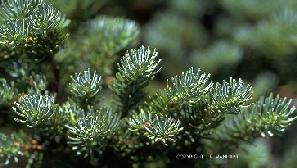

Subalpine Fir
Abies lasiocarpa (Hook.) Nutt
The subalpine fir was among the plants reportedly recorded by Lewis and Clark along the Lolo Trail in September 1805.
Fir tree that grows up 25 feet with narrow, spire-shaped crown, short, thick branches, and resin blisters on the bark. It has blunt needles which are bluish-green and turn upwards. There are large cylindrical seed cones, deep purple, lighten with age, erect near top of tree. It is distinguished by its very conical silhouette, and its smooth bark covered with resin blisters. Shrubby at timberline and often much broader than tall with short stiff branches and blunt and resinous leaves. Common and abundant at sub alpine elevations, also at low elevations in moister areas
Food Uses: The cones were ground into powder and mixed with animal fat or marrow. Cooled until it hardened, it could be served.
Medicinal Uses:
The pitch and bark preparations were used for
wounds, eye injuries or even taken internally for respiratory ailments.
When mixed with deer grease it could be used as a salve. Fir tea could be used
for colds. The needles were used in poultices for fevers and chest colds.
Other Uses:
The fragrant young leaves and twigs are used to repel moths or are burnt as
an incense. They were also ground into a powder and used to make a baby powder
and perfumes. A gum is obtained from the bark. It is antiseptic and was chewed
by the N. American Indians in order to clean the teeth.. It was also used to
plug holes in canoes. An infusion of the leaves is used as a hair tonic. The
leaves can also be placed in the shoes as a foot deodorant.
Wood - light, soft, not strong. It is little used except as a fuel and for pulp.
The native North American Indians used it for making chairs and insect-proof
storage boxes. It was also used as a fuel and was said to burn for a long time.
The crushed foliage has a balsam aroma.